University: Porter's Diamond Theory and National Advantage Report
VerifiedAdded on 2023/06/10
|6
|1183
|147
Report
AI Summary
This report provides an analysis of Porter's Diamond Theory, a model developed to understand how industries and organizations can achieve a competitive advantage at both national and international levels. The report explores the key determinants of the model, including factor conditions (such as resources and infrastructure), related and supporting industries, home demand conditions, and the role of strategy, structure, and rivalry within organizations. It also considers the influence of government policies. The report discusses the importance of factor conditions, the various ways the model can be used across different organizations and industries, and applies the model to the mobile telecommunication industry. Finally, it acknowledges the limitations of the model, particularly its focus on domestic markets and its applicability to developed countries. The report concludes by highlighting the relevance of the model in understanding the dynamics of international competitiveness.
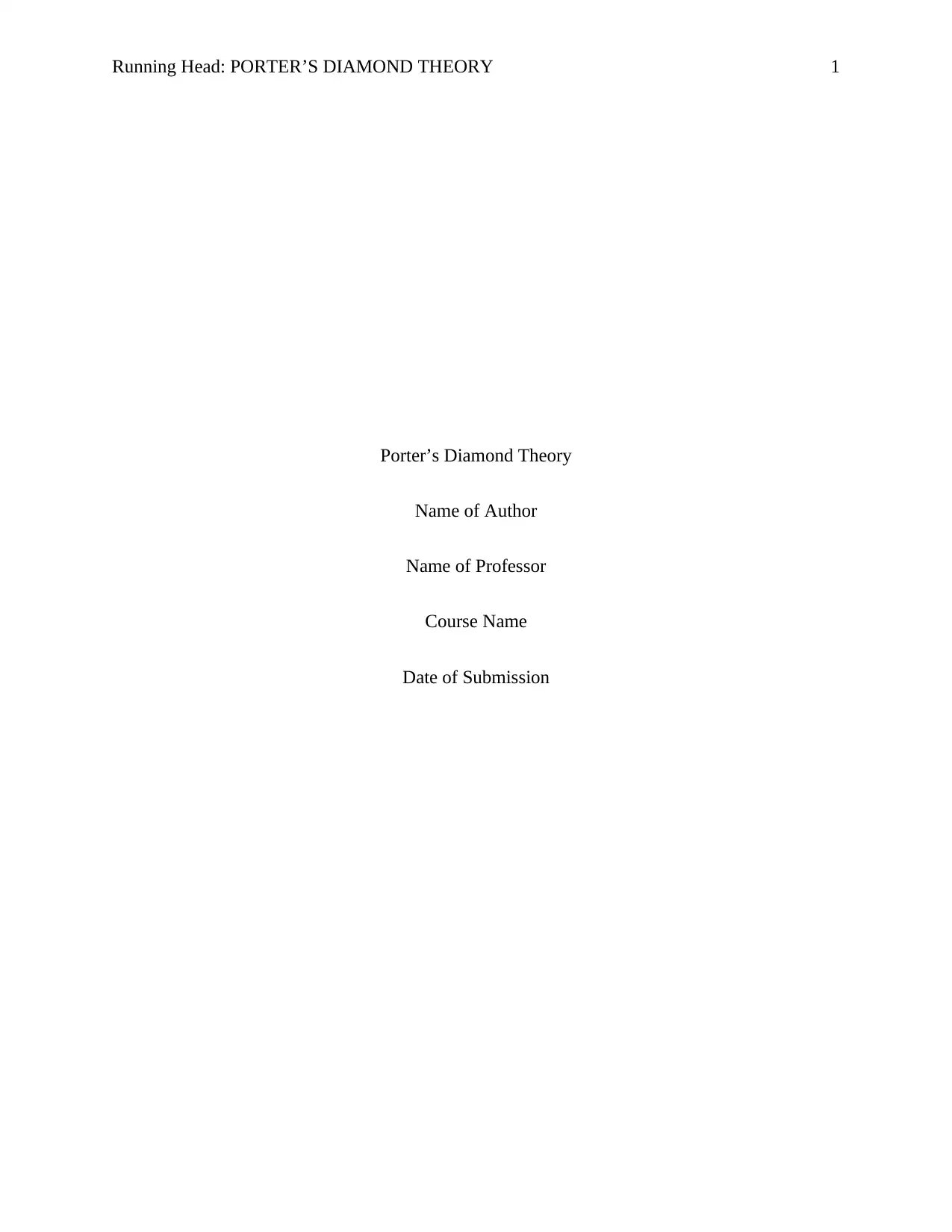
Running Head: PORTER’S DIAMOND THEORY 1
Porter’s Diamond Theory
Name of Author
Name of Professor
Course Name
Date of Submission
Porter’s Diamond Theory
Name of Author
Name of Professor
Course Name
Date of Submission
Paraphrase This Document
Need a fresh take? Get an instant paraphrase of this document with our AI Paraphraser
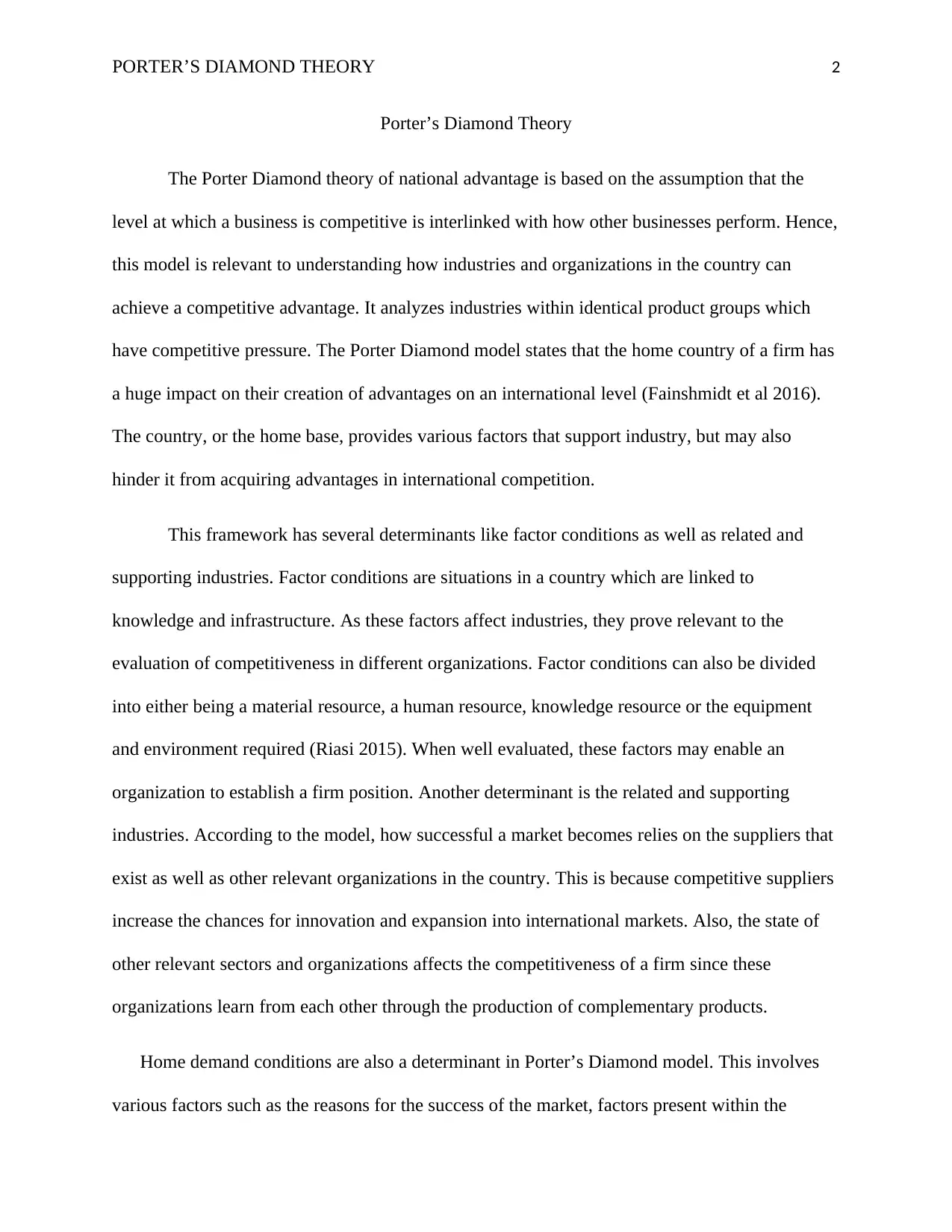
PORTER’S DIAMOND THEORY 2
Porter’s Diamond Theory
The Porter Diamond theory of national advantage is based on the assumption that the
level at which a business is competitive is interlinked with how other businesses perform. Hence,
this model is relevant to understanding how industries and organizations in the country can
achieve a competitive advantage. It analyzes industries within identical product groups which
have competitive pressure. The Porter Diamond model states that the home country of a firm has
a huge impact on their creation of advantages on an international level (Fainshmidt et al 2016).
The country, or the home base, provides various factors that support industry, but may also
hinder it from acquiring advantages in international competition.
This framework has several determinants like factor conditions as well as related and
supporting industries. Factor conditions are situations in a country which are linked to
knowledge and infrastructure. As these factors affect industries, they prove relevant to the
evaluation of competitiveness in different organizations. Factor conditions can also be divided
into either being a material resource, a human resource, knowledge resource or the equipment
and environment required (Riasi 2015). When well evaluated, these factors may enable an
organization to establish a firm position. Another determinant is the related and supporting
industries. According to the model, how successful a market becomes relies on the suppliers that
exist as well as other relevant organizations in the country. This is because competitive suppliers
increase the chances for innovation and expansion into international markets. Also, the state of
other relevant sectors and organizations affects the competitiveness of a firm since these
organizations learn from each other through the production of complementary products.
Home demand conditions are also a determinant in Porter’s Diamond model. This involves
various factors such as the reasons for the success of the market, factors present within the
Porter’s Diamond Theory
The Porter Diamond theory of national advantage is based on the assumption that the
level at which a business is competitive is interlinked with how other businesses perform. Hence,
this model is relevant to understanding how industries and organizations in the country can
achieve a competitive advantage. It analyzes industries within identical product groups which
have competitive pressure. The Porter Diamond model states that the home country of a firm has
a huge impact on their creation of advantages on an international level (Fainshmidt et al 2016).
The country, or the home base, provides various factors that support industry, but may also
hinder it from acquiring advantages in international competition.
This framework has several determinants like factor conditions as well as related and
supporting industries. Factor conditions are situations in a country which are linked to
knowledge and infrastructure. As these factors affect industries, they prove relevant to the
evaluation of competitiveness in different organizations. Factor conditions can also be divided
into either being a material resource, a human resource, knowledge resource or the equipment
and environment required (Riasi 2015). When well evaluated, these factors may enable an
organization to establish a firm position. Another determinant is the related and supporting
industries. According to the model, how successful a market becomes relies on the suppliers that
exist as well as other relevant organizations in the country. This is because competitive suppliers
increase the chances for innovation and expansion into international markets. Also, the state of
other relevant sectors and organizations affects the competitiveness of a firm since these
organizations learn from each other through the production of complementary products.
Home demand conditions are also a determinant in Porter’s Diamond model. This involves
various factors such as the reasons for the success of the market, factors present within the
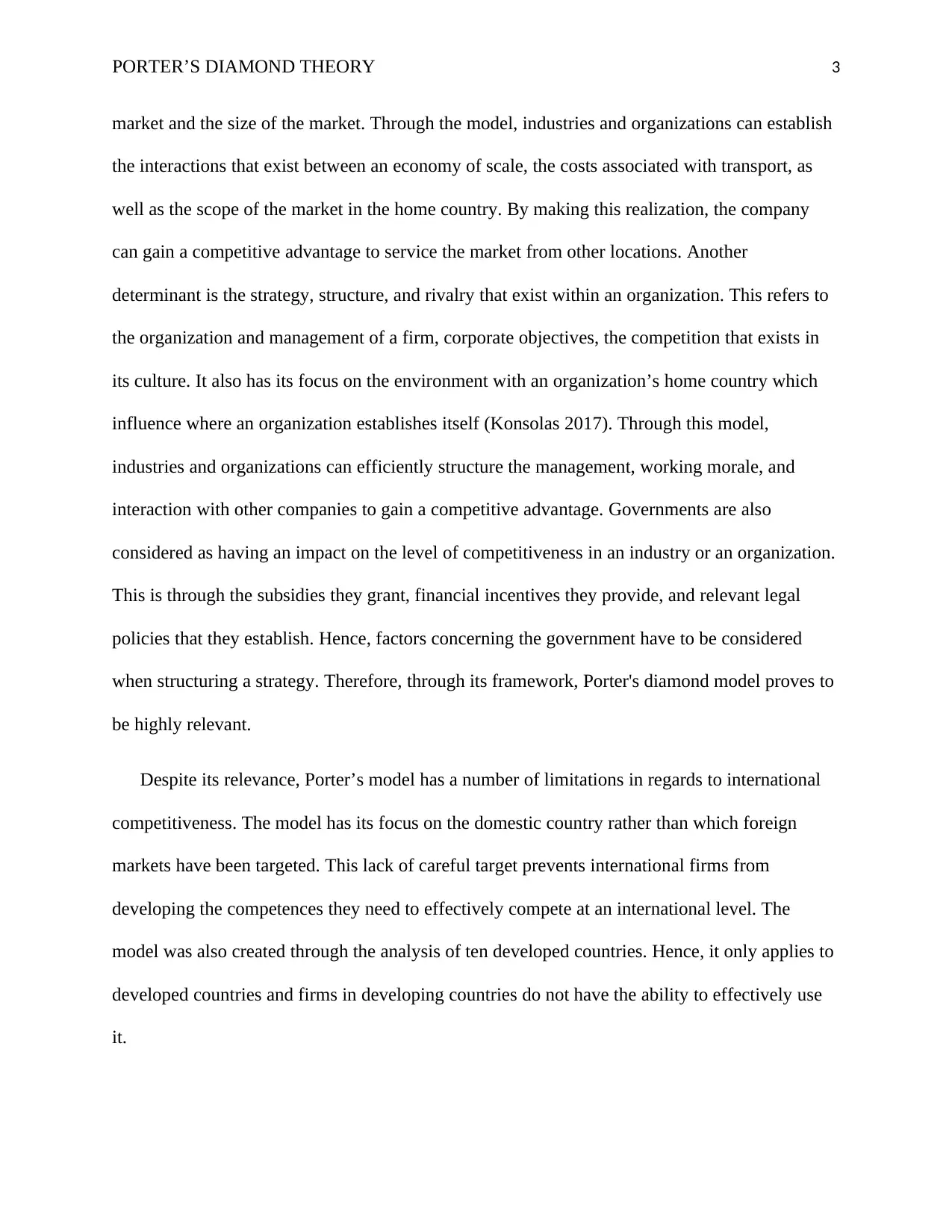
PORTER’S DIAMOND THEORY 3
market and the size of the market. Through the model, industries and organizations can establish
the interactions that exist between an economy of scale, the costs associated with transport, as
well as the scope of the market in the home country. By making this realization, the company
can gain a competitive advantage to service the market from other locations. Another
determinant is the strategy, structure, and rivalry that exist within an organization. This refers to
the organization and management of a firm, corporate objectives, the competition that exists in
its culture. It also has its focus on the environment with an organization’s home country which
influence where an organization establishes itself (Konsolas 2017). Through this model,
industries and organizations can efficiently structure the management, working morale, and
interaction with other companies to gain a competitive advantage. Governments are also
considered as having an impact on the level of competitiveness in an industry or an organization.
This is through the subsidies they grant, financial incentives they provide, and relevant legal
policies that they establish. Hence, factors concerning the government have to be considered
when structuring a strategy. Therefore, through its framework, Porter's diamond model proves to
be highly relevant.
Despite its relevance, Porter’s model has a number of limitations in regards to international
competitiveness. The model has its focus on the domestic country rather than which foreign
markets have been targeted. This lack of careful target prevents international firms from
developing the competences they need to effectively compete at an international level. The
model was also created through the analysis of ten developed countries. Hence, it only applies to
developed countries and firms in developing countries do not have the ability to effectively use
it.
market and the size of the market. Through the model, industries and organizations can establish
the interactions that exist between an economy of scale, the costs associated with transport, as
well as the scope of the market in the home country. By making this realization, the company
can gain a competitive advantage to service the market from other locations. Another
determinant is the strategy, structure, and rivalry that exist within an organization. This refers to
the organization and management of a firm, corporate objectives, the competition that exists in
its culture. It also has its focus on the environment with an organization’s home country which
influence where an organization establishes itself (Konsolas 2017). Through this model,
industries and organizations can efficiently structure the management, working morale, and
interaction with other companies to gain a competitive advantage. Governments are also
considered as having an impact on the level of competitiveness in an industry or an organization.
This is through the subsidies they grant, financial incentives they provide, and relevant legal
policies that they establish. Hence, factors concerning the government have to be considered
when structuring a strategy. Therefore, through its framework, Porter's diamond model proves to
be highly relevant.
Despite its relevance, Porter’s model has a number of limitations in regards to international
competitiveness. The model has its focus on the domestic country rather than which foreign
markets have been targeted. This lack of careful target prevents international firms from
developing the competences they need to effectively compete at an international level. The
model was also created through the analysis of ten developed countries. Hence, it only applies to
developed countries and firms in developing countries do not have the ability to effectively use
it.
⊘ This is a preview!⊘
Do you want full access?
Subscribe today to unlock all pages.

Trusted by 1+ million students worldwide
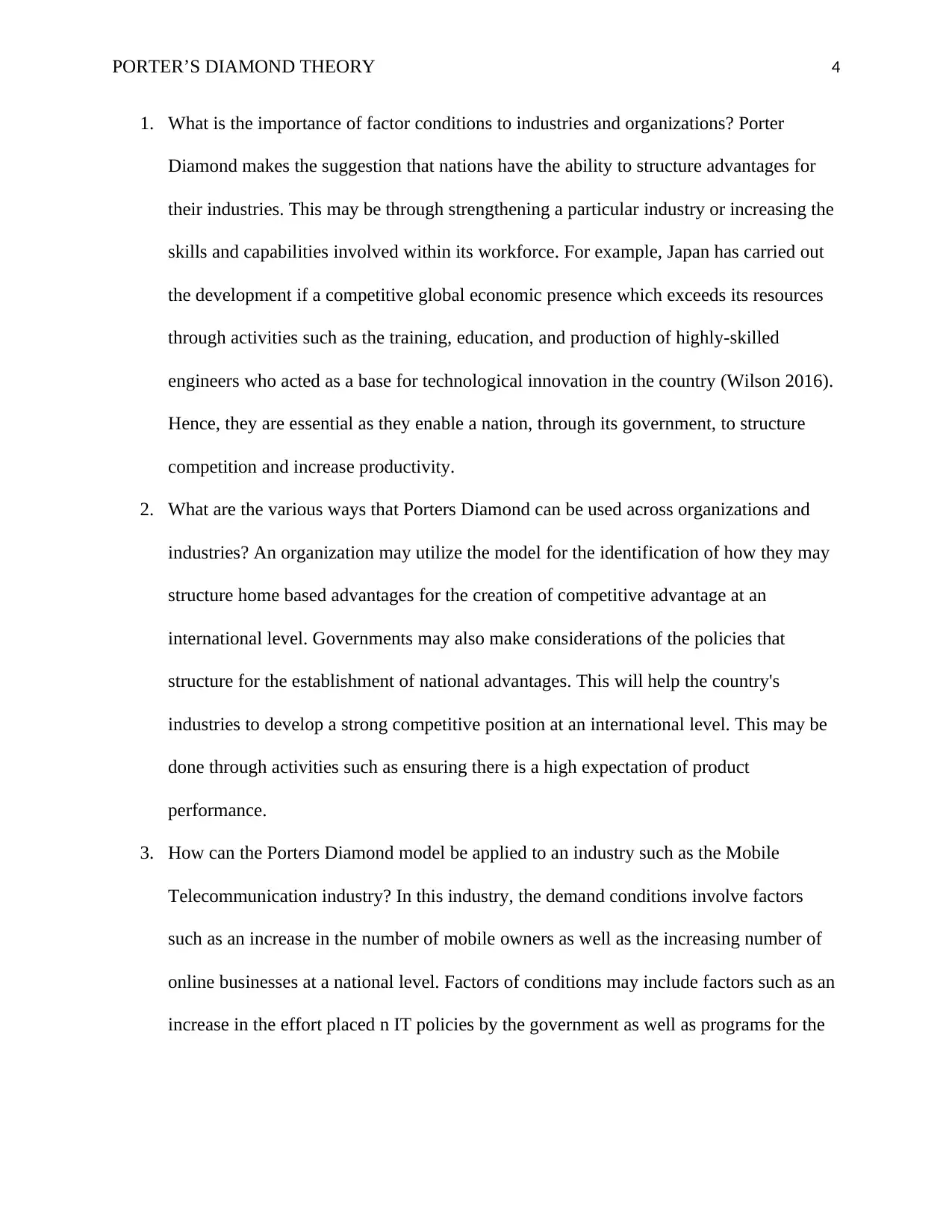
PORTER’S DIAMOND THEORY 4
1. What is the importance of factor conditions to industries and organizations? Porter
Diamond makes the suggestion that nations have the ability to structure advantages for
their industries. This may be through strengthening a particular industry or increasing the
skills and capabilities involved within its workforce. For example, Japan has carried out
the development if a competitive global economic presence which exceeds its resources
through activities such as the training, education, and production of highly-skilled
engineers who acted as a base for technological innovation in the country (Wilson 2016).
Hence, they are essential as they enable a nation, through its government, to structure
competition and increase productivity.
2. What are the various ways that Porters Diamond can be used across organizations and
industries? An organization may utilize the model for the identification of how they may
structure home based advantages for the creation of competitive advantage at an
international level. Governments may also make considerations of the policies that
structure for the establishment of national advantages. This will help the country's
industries to develop a strong competitive position at an international level. This may be
done through activities such as ensuring there is a high expectation of product
performance.
3. How can the Porters Diamond model be applied to an industry such as the Mobile
Telecommunication industry? In this industry, the demand conditions involve factors
such as an increase in the number of mobile owners as well as the increasing number of
online businesses at a national level. Factors of conditions may include factors such as an
increase in the effort placed n IT policies by the government as well as programs for the
1. What is the importance of factor conditions to industries and organizations? Porter
Diamond makes the suggestion that nations have the ability to structure advantages for
their industries. This may be through strengthening a particular industry or increasing the
skills and capabilities involved within its workforce. For example, Japan has carried out
the development if a competitive global economic presence which exceeds its resources
through activities such as the training, education, and production of highly-skilled
engineers who acted as a base for technological innovation in the country (Wilson 2016).
Hence, they are essential as they enable a nation, through its government, to structure
competition and increase productivity.
2. What are the various ways that Porters Diamond can be used across organizations and
industries? An organization may utilize the model for the identification of how they may
structure home based advantages for the creation of competitive advantage at an
international level. Governments may also make considerations of the policies that
structure for the establishment of national advantages. This will help the country's
industries to develop a strong competitive position at an international level. This may be
done through activities such as ensuring there is a high expectation of product
performance.
3. How can the Porters Diamond model be applied to an industry such as the Mobile
Telecommunication industry? In this industry, the demand conditions involve factors
such as an increase in the number of mobile owners as well as the increasing number of
online businesses at a national level. Factors of conditions may include factors such as an
increase in the effort placed n IT policies by the government as well as programs for the
Paraphrase This Document
Need a fresh take? Get an instant paraphrase of this document with our AI Paraphraser
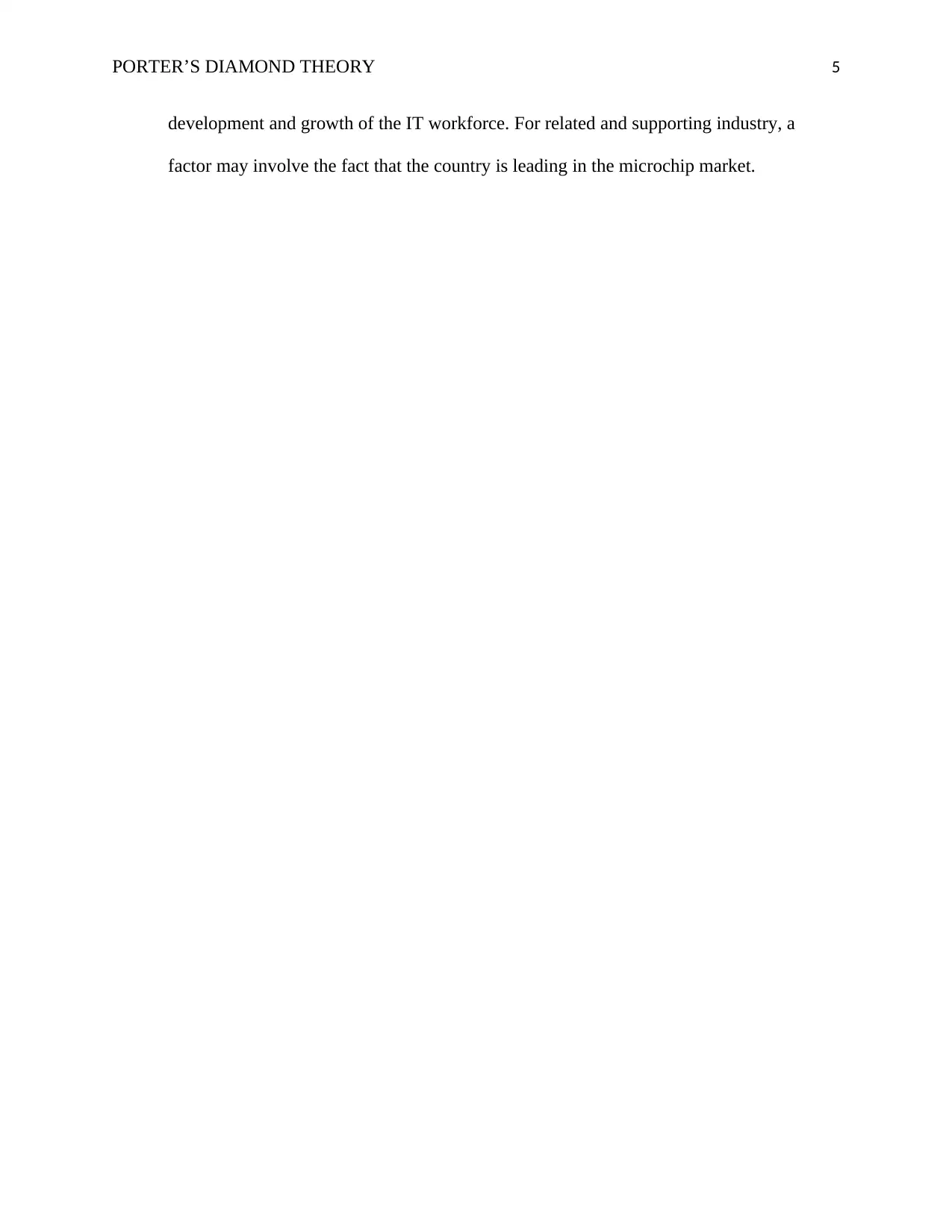
PORTER’S DIAMOND THEORY 5
development and growth of the IT workforce. For related and supporting industry, a
factor may involve the fact that the country is leading in the microchip market.
development and growth of the IT workforce. For related and supporting industry, a
factor may involve the fact that the country is leading in the microchip market.
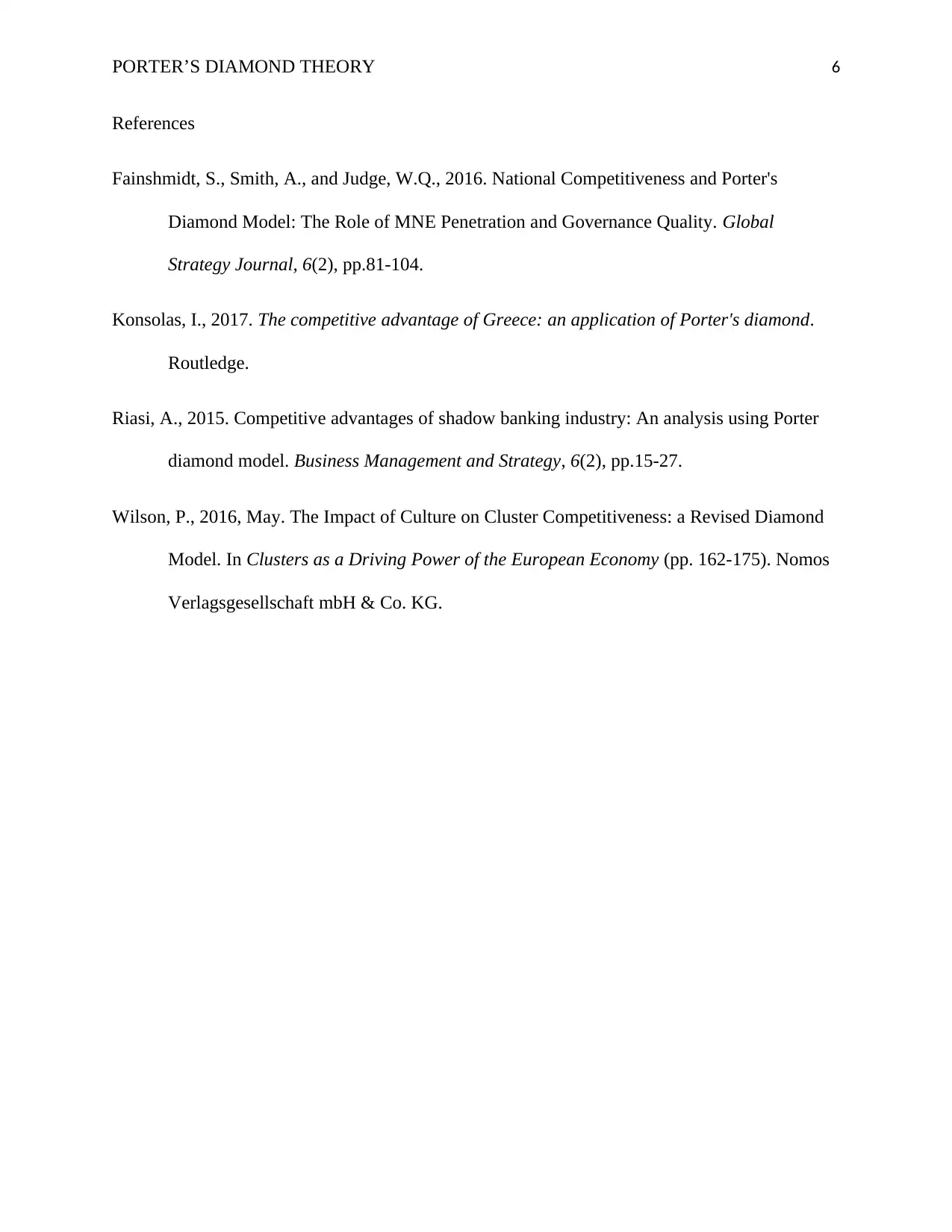
PORTER’S DIAMOND THEORY 6
References
Fainshmidt, S., Smith, A., and Judge, W.Q., 2016. National Competitiveness and Porter's
Diamond Model: The Role of MNE Penetration and Governance Quality. Global
Strategy Journal, 6(2), pp.81-104.
Konsolas, I., 2017. The competitive advantage of Greece: an application of Porter's diamond.
Routledge.
Riasi, A., 2015. Competitive advantages of shadow banking industry: An analysis using Porter
diamond model. Business Management and Strategy, 6(2), pp.15-27.
Wilson, P., 2016, May. The Impact of Culture on Cluster Competitiveness: a Revised Diamond
Model. In Clusters as a Driving Power of the European Economy (pp. 162-175). Nomos
Verlagsgesellschaft mbH & Co. KG.
References
Fainshmidt, S., Smith, A., and Judge, W.Q., 2016. National Competitiveness and Porter's
Diamond Model: The Role of MNE Penetration and Governance Quality. Global
Strategy Journal, 6(2), pp.81-104.
Konsolas, I., 2017. The competitive advantage of Greece: an application of Porter's diamond.
Routledge.
Riasi, A., 2015. Competitive advantages of shadow banking industry: An analysis using Porter
diamond model. Business Management and Strategy, 6(2), pp.15-27.
Wilson, P., 2016, May. The Impact of Culture on Cluster Competitiveness: a Revised Diamond
Model. In Clusters as a Driving Power of the European Economy (pp. 162-175). Nomos
Verlagsgesellschaft mbH & Co. KG.
⊘ This is a preview!⊘
Do you want full access?
Subscribe today to unlock all pages.

Trusted by 1+ million students worldwide
1 out of 6
Related Documents
Your All-in-One AI-Powered Toolkit for Academic Success.
+13062052269
info@desklib.com
Available 24*7 on WhatsApp / Email
![[object Object]](/_next/static/media/star-bottom.7253800d.svg)
Unlock your academic potential
Copyright © 2020–2025 A2Z Services. All Rights Reserved. Developed and managed by ZUCOL.





